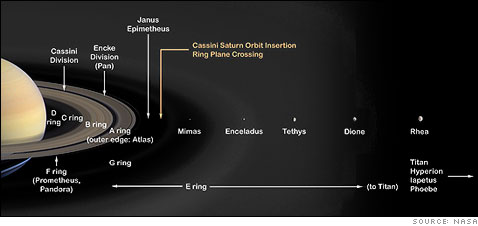Saturn's Rings

Saturn's spectacular ring system is unique in the solar system, with uncountable billions of tiny particles of water ice (with traces of other material) in orbit around the planet. The ring particles range in size from smaller than grains of sugar to as large as a house. The main rings stretch out from about 4,350 mi (7,000 km) to above the atmosphere of the planet out to the F ring, a total span of 45,984 mi (74,000 km). Saturn's rings can be likened to a phonograph, rings within rings numbering in the hundreds, with spokes in the B rings, and shepherding satellites controlling the F ring.
The main rings are called the A, B, and C rings, moving from outside to inside. The gap between the A and B rings is called Cassini's Division and is named for the Italian-French astronomer Gian Domenico Cassini, who discovered four of Saturn's major moons and the dark, narrow gap splitting the planet's rings. In Sept. 2004, the Cassini-Huygens mission discovered a new ring located between the A and F rings. Designated S/2004 1R, the ring is estimated to be about 190 mi (300 km) wide, but it has not yet been verified if the ring entirely circles the planet.
Saturn's magnetic field has well-defined north and south magnetic poles, and is aligned with Saturn's axis of rotation to within one degree.
 SATURN'S RINGS AND MOONS. The particles in Saturn's rings are composed primarily of water ice and range in size from microns to tens of meters. Saturn has 56 known moons; those shown are the major ones. Source: NASA/JPL.
|







